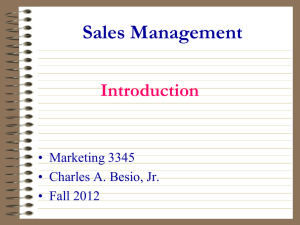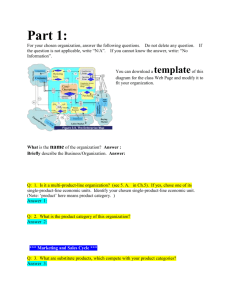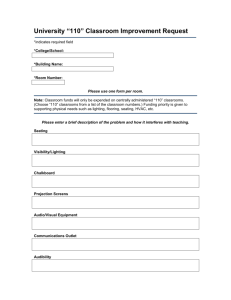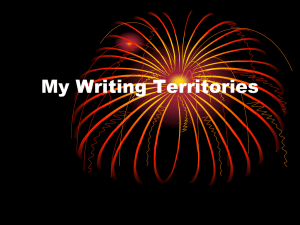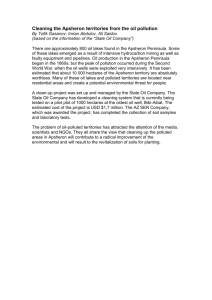Groups in Context
advertisement
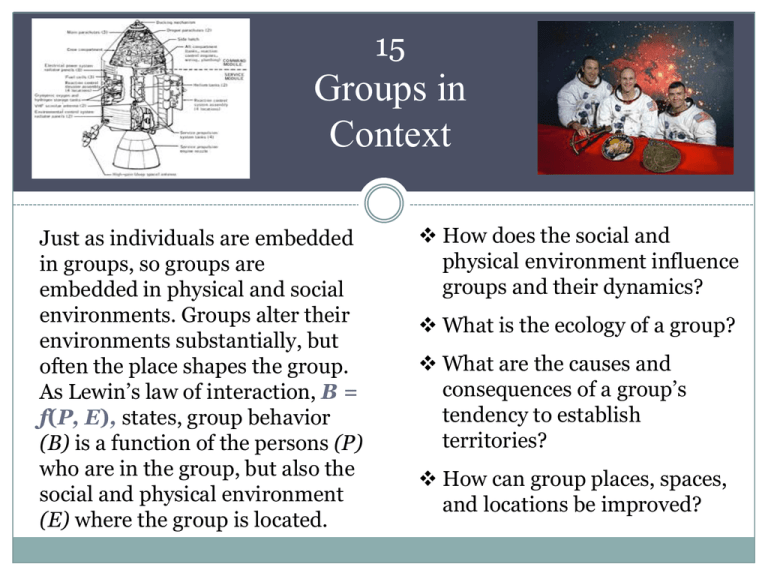
15 Groups in Context Just as individuals are embedded in groups, so groups are embedded in physical and social environments. Groups alter their environments substantially, but often the place shapes the group. As Lewin’s law of interaction, B = f(P, E), states, group behavior (B) is a function of the persons (P) who are in the group, but also the social and physical environment (E) where the group is located. How does the social and physical environment influence groups and their dynamics? What is the ecology of a group? What are the causes and consequences of a group’s tendency to establish territories? How can group places, spaces, and locations be improved? Places Spaces Locations Design A sense of place Personal space Types of territories The personplace fit Stressful places Spatial invasion Group territories Fitting form to function Dangerous places Seating Territoriality in groups Case: Apollo 13 All groups exist somewhere Lewin’s field theory: B = f (P, E) “E” includes the physical, behavioral, and interpersonal environment Examples of groups in specific environmental contexts …work teams, gangs, Impressionists, fraternities, classes, airline pilots, astronauts A sense of place Activation Tense Jittery Excited Enthusiastic Elated Upset Distressed Happy Displeasure Pleasure Ambience Sad Serene Gloomy Contented Tired Placid Lethargic Calm Deactivation Cognitive Overload • A psychological reaction to situations and experiences that are so cognitively, perceptually, or emotionally stimulating that they tax or even exceed the individual’s capacity to process incoming information. Attention Restoration Theory • cognitive resources can be replenished through interaction with natural environments (Kaplan, 2008) Stressful places Stress: Negative physiological, emotional, cognitive, and behavioral responses to circumstances that threaten—or are thought to threaten—one’s sense of well-being and safety. We have strong feelings in and about places. Some places make us feel good: glad to be there, relaxed, excited, warm all over…Other places make us feel bad: uncomfortable, insignificant, unhappy, out of place. We avoid these places and suffer if we have to be in them. Farbstein & Kantrowitz, 1978 Danger Noise Unpleasant temperature Dangerous places EUEs (extreme and unusual environments) Groups that survive in EUEs respond by becoming better groups—more organized, more cohesive, and more efficient. Those that do not display breakdowns in team coordination, communication, and leadership. Environmental contexts that are unlike those where humans usually live, including confined and isolated environments. A number of groups fail to deal successfully with the challenges of an EUE (e.g., Mount Everest) Places A sense of place Stressful places Dangerous places Spaces Locations Small Personal Group space Ecology Spatial invasion Just as frogs issue their croaks from their favorite places in the Seating stream, and birds neatly space themselves along a telephone wire, so humans display consistent patterns of spacing and seating when immersed in a group habitat. Design Group ecology includes spatial and seating dynamics Personal space: Maintaining distance between oneself and others Crowding: Reaction to spatial invasion Seating (and standing) arrangement: how the group is arranged in the physical place Personal space The area that individuals maintain around themselves into which others cannot intrude without arousing discomfort. Personal space Personal space Hall’s concept of interpersonal zones Note: Hall did not include a “remote” zone The Remote Zone: E-groups • Online vs. Offline groups • Social presence can be very high in online groups Personal space Sex differences in space needs Status and space Cross-cultural variations in spatial dynamics Equilibrium model of communication Spatial invasion Density v. Cognitive Density- Control crowding reactions intensity and inter- to hypothesis ference crowding (Freedman) Seating Although often unrecognized, or simply taken for granted, seating patterns influence interaction, communication, and leadership in groups. sociofugal seating arrangements discourage interaction sociopetal seating promotes interaction Sommer’s (1967) analysis of seating choices Seating 60 50 40 Percent choosing each seating arrangement 30 20 10 0 Conversing Cooperating Competing Coacting Places SpacesTerritoriality Locations “A territory is an area of space, whether of water or earth Types of or air, territories which an animal or group of animals defends as an exclusive preserve. Group Robert territoriesArdrey A territorial species of animals, The Territoriality therefore, is one in Territorial in groups Imperative which all males, and sometimes females too, bear an inherent drive to gain and defend an exclusive property.” Design Types of territories Altman (1975) describes three basic types of human territories: Primary, secondary, and public Third Places People’s homes and work places are usually primary territories (first and second places). Oldenburg calls secondary territories located in semipublic areas, usually in an urban location, where people go to meet their friends, socialize, and “hang out” Third Places. Some online “territories” can serve as third places, such as this location in World of Warcraft A seat in a classroom is also a secondary territory Haber (1980) found that 88% of all students establish a "zone" in a class (an area of 2 or 3 seats where they regularly sit) she asked volunteers to sit in someone else's seat in a class, but many couldn't do it 27% of the students asked for their seat back some blushed when they saw someone in their seat those who surrendered their seat came to next class early strongest rebuke if invasion took place during a break in class Group territories We didn’t rally them there. We never went looking for trouble. We only rallied on our own street, but we always won there. -- Doc, leader of the Nortons Examples: Gangs, “turf wars,” tags, and graffiti Group space: temporary territories Consequences of territoriality adjustment and stress intergroup conflict home advantage Territoriality in groups Functions • Privacy • Regularizing (organizing) • Establishing identity Status • Higher status members usually control larger, higher quality territories Defense • Intrusions usually generate emotional reactions Groups in EUEs • Adjustment depends on managing territoriality effectively Places The PersonPlace Fit Behavior Setting Locations •Spaces Barker studied groups in their natural locations • He concluded most behavior is determined by fit between Types of the place and the person territories Group • physically and temporally territories bounded social situations • checkout-line, classroom, elevator Territoriality in groups Elements • • • • geographically fixed boundaries components program: determine behavior in the place Design The personplace fit Fitting form to function Staffing theory Fitting form to function Synomophy • fit between people and the place Understaffing Staffing theory • • fit between number of people, tasks, and setting • heavy workload • Involving • commitment Overstaffing • low moral • too little to do • unengaged Fitting form to function Staffing theory Overstaffed Groups Encourage members Restrict membership Overstaffing Punish deviance Divide Other Understaffed Groups RecruitUnderstaffing new members Reorganize Other 0 10 20 30 Percentage 40 50 60 Duffy’s group workplace design Hives Groups live and work best in places that are deliberately designed to match the members’ needs and the group’s needs. Work is divisible, individualized, structured; requires little interaction with other members. Dens Collective tasks and projects; equally skilled members work in an open space that all members share. Cells Work is complex, long-term, individualized; private spaces needed Clubs Diverse tasks and projects that vary greatly in their collaborative demands; members are talented, welltrained, or possess very specialized skills Places Spaces Locations Design A sense of place Personal space Types of territories The personplace fit Stressful places Spatial invasion Group territories Fitting form to function Dangerous places Seating Territoriality in groups


